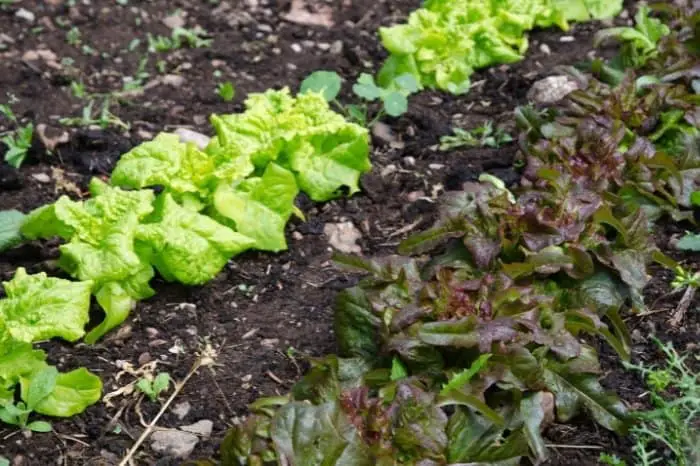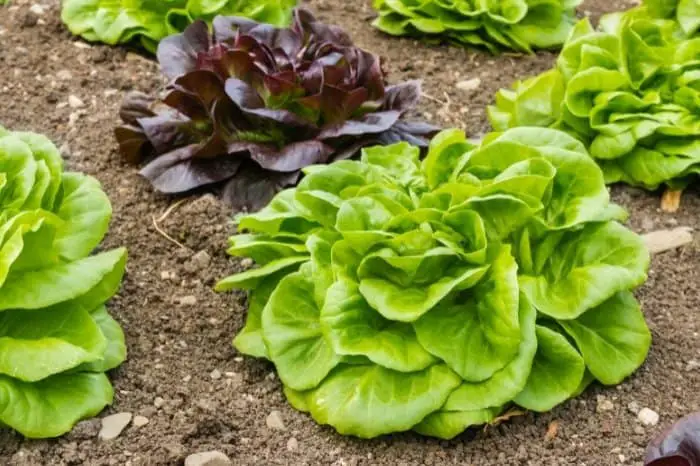Last Updated on October 29, 2022
The crispy, green, and lush lettuce is one of the most loved and widely grown salads vegetables grown in the United States. Spacing your lettuce the right way is crucial for you to enjoy a great crop yield. So, how far apart should our lettuce be planted?
Lettuce is a cool-weathered crop that grows easily in the right conditions. It is one of most growers’ favorite garden greens that has a great taste and offers great Vitamin content (especially Vitamin A).
We will be looking at how far apart your lettuce should be planted. We will also be giving you great guidelines for growing lettuce in your garden so you can enjoy these great-tasting greens.
Growing Lettuce
Lettuce is an amazing vegetable to add to your vegetable home garden. You can always enjoy your salad bowl full of this crispy, green, and tasty lettuce available right in the comfort of your home.
Lettuce is an easy-to-grow plant that will keep producing for a long time. You can start to enjoy baby green lettuce harvest around a month from seedling then full head in about two months or even less.
The plant isn’t so demanding so far you keep it watered appropriately. Lettuce will grow optimally in containers as well as raised beds. Therefore, this makes lettuce perfect for a small spaced garden.

Ideally, lettuce is best grown in spring and fall. It should be planted two weeks before frost. Then in fall, you should begin seed sowing again six weeks to eight weeks before your region’s fall frost.
How Far Apart Should Lettuce Be Planted?
How far apart your lettuce should be planted will mainly depend on the lettuce variety you’re growing.
For instance, the loose-leaf lettuce variety can be grown closely or tightly. Heading lettuce on the other hand requires some space.
When you start by transplanting lettuce from indoor, it makes it easier to space them. Then planting outdoors from seeds is easier to sprinkle the seeds and thin them later.
So, let’s look at the spacing requirements for butter lettuce, loose-leaf lettuce, and crisphead lettuce. We will also look at how far apart lettuce should be planted container gardening and hydroponics garden.
How To Plant Lettuce: Spacing Requirements Tips
Here are some spacing requirement tips for growing some lettuce varieties as well as container and hydroponics garden:
1. Loose-leaf Lettuce
For transplanting, how far apart your loose-leaf lettuce should be planted should be 2 to 4 inches. If you’re planting in rows, you can plant them 1 inch apart and the rows should be 8 to 10 inches intervals. A general guideline for planting lettuce in a row is 10 plants per foot.

Most times, growers prefer not to thin loose-lettuce. They are usually picked or harvested while they’re young. They are also harvested several times in one season and this limits their chance of fungus or mold infestation.
2. Butter Lettuce
If you give butter lettuce variety adequate space, they will tend to give rise to a semi-firm head. Butter lettuce can as well be tightly packed just like loose-leaf lettuce. Or you can simply space them out to give them a good chance to grow a semi-firm head and to grow larger.
If you wish to achieve a bigger head, space them 6 to 8 inches apart. Row planting should be thinned out into 6 inches then space these rows at 10 to 18 intervals.
3. Crisphead Lettuce
The crisphead lettuce variety accommodates more space and they may be the most difficult variety to grow. This lettuce variety requires more care so they can produce that firm and mild-tasting heads you see on grocery store shelves.
Crisphead lettuce variety should be spaced 12 to 18 inches apart. However, the Romaine variety that tends to grow tall heads can be spaced as close as 6 inches apart. Row planting should be spaced 6 to 12 inches apart in rows at 18 inches intervals.
AeroGarden Black Harvest Indoor Hydroponic Garden
4. Container Gardening Space Requirement
A lot of growers that grow lettuce in containers have grown them very closely and overlooked spacing suggestions with success.
The ability to closely pack lettuce makes it even more ideal to be grown in containers. When you harvest the outer leaves of butter lettuce and loose-leaf lettuce varieties in your containers, the plant tends to continually produce more leaves from the central crown.
Therefore, this attribute or feature permits us to continue harvesting all season long. Also, doing this allows you to create more room for new leaves to grow.
5. Hydroponics Garden Lettuce Space Requirement
Some lettuce varieties cultivated in various hydroponic systems have been spaced closer to each other. In hydroponic lettuce, their root does not require nutrient competition compared to growing them traditionally. Hence, they don’t need the same amount of space as growing lettuce traditionally outdoors.
The crisphead varieties can be grown as close as 4 inches apart in a hydroponic garden.
Guidelines On Planting Lettuce
Follow these guidelines to plant your lettuce:
- To plant lettuce from seeds, sow them ¼ to ½ inch deep. Seeds aren’t sown too deep because they require light to grow. The ideal temperature for seeds germination is around 40 F. However, the ideal growing temperatures are between 60 to 65 degrees Fahrenheit. Once the leaves have 3 to 4 true leaves, they can be thinned.
- If you’re transplanting, the transplant should have 4 to 6 mature leaves. The root system should also be developed before transplanting.
- Ensure you water thoroughly after planting. Make sure you always water lettuce sparingly and frequently. Your aim is to maintain moist soil. Always avoid too much watering because overwatering can lead to root rot, diseases, and stunted growth.
- Once it’s 3 weeks of transplanting, you should supply fertilizer to your plant soil. Lettuce soil thrives well in high organic components. Use adequate compost and a steady supply of nitrogen so it can grow well.
FAQ’s
Can lettuce be grown in containers?
Yes, it can. There are many different varieties of lettuce that can be grown indoors. Check out some of the many varieties of lettuce that are available online. If you are growing indoors, I would recommend choosing a variety of lettuce that is harvested when its head is still small (4-5 inches). This will allow the plant to continue to grow and produce leaves, but not so much that they get too big and unappealing.
Does lettuce need a lot of water?
Lettuce is a very easy crop to grow. It doesn't need a lot of water, and you can grow it in almost any soil, including sand. It grows fast and reaches maturity within about 60 days. The lettuce that I grow in my garden are loose-leaf varieties. These lettuces do not form heads, so they will continue to grow and produce leaves even when the main head is harvested.
What's the best time to plant lettuce?
Lettuce should be planted in cool weather. This will give it a good chance of survival. It will do well with temperatures around 45 degrees F. I recommend planting it in mid-spring, and in mid-fall.
What type of soil does lettuce need?
Lettuce is a cool-season crop and thrives in soils with good drainage. It can be grown in sandy, clay, loam, or peaty soils as long as they are not compacted. Lettuce requires good air circulation around the roots, but it will tolerate light shade. To keep the roots moist, water regularly.
How long does it take for lettuce to germinate?
According to the University of California, you should expect to see lettuce sprouting around 5-7 days after the seed is planted.
How Far Apart Should Lettuce Be Planted: Conclusion
Lettuce is great-tasting veg that is pretty easy to grow. Ensure you follow our tips on how far apart your lettuce should be planted so you can enjoy some crispy great tasting lettuce.

Eunice is an enthusiastic gardener with a passion for growing beautiful flowers. She loves nothing more than spending time in her garden, tending to her plants and enjoying the outdoors. Eunice has been gardening for over 15 years and has developed a unique style of landscaping that is both practical and aesthetically pleasing. She is especially fond of growing roses and enjoys experimenting with different varieties and colors. Eunice takes great pride in her garden and often shares the fruits of her labor with friends and family. In her spare time, she enjoys reading gardening magazines and attending local horticulture events. Eunice is passionate about her hobby and is always eager to share her knowledge and experience with others.

